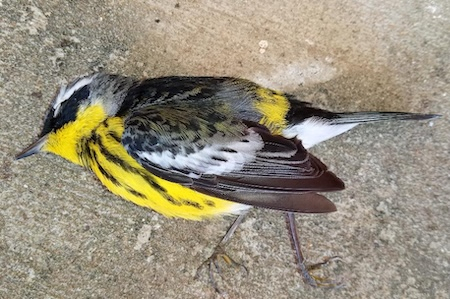
A migrating male magnolia warbler dead from a window strike.
June 10, 2024 - Several weeks ago, I got to see my first magnolia warbler. Unfortunately, it was dead next to a window behind the Tyler Rose Center and did not nearly finish his trip from Central America to the Boreal forests of Canada.
Birds have excellent vision, but they do not perceive glass as humans do. Scientists estimate up to one billion birds die colliding with glass windows each year. There are two main reasons why birds collide with windows:
- Reflections: Glass reflects the surrounding environment, such as trees and sky, making it appear as an extension of their habitat. Birds fly toward these reflections, not realizing there is a solid barrier in their path.
- Transparency: Birds can see through windows to the other side of the house, especially if there are attractive plants or light sources. This gives the illusion of a clear passageway, leading to collisions when they attempt to fly through.
The impact of window collisions is significant. Species that are especially vulnerable include migratory songbirds, which often travel at night and rest during the day. When they encounter reflective or transparent glass during daylight hours, the risk of collision increases.
The good news is that there are several effective strategies to prevent bird strikes. These solutions can be applied to various types of windows and glass surfaces around the home.
- Decals and Stickers: Applying decals, stickers, or tape to the outside of windows can break up reflections and make the glass visible to birds. To be effective, patterns should cover the entire window with spacing no more than 2-4 inches apart.
- Window Films: Installing one-way transparent films on the outside of windows can reduce reflectivity while maintaining visibility from inside the home. These films are effective in making windows more visible to birds without obstructing the view for homeowners.
- Screens: Installing external screens can provide a physical barrier that prevents birds from hitting the glass. Screens can also reduce the reflectivity of windows.
- Netting: Lightweight netting placed a few inches away from the window acts as a cushion if a bird flies into it. This reduces the likelihood of injury.
- Close Blinds and Curtains: When not in use, closing blinds or curtains can make windows less transparent and reduce the chances of birds attempting to fly through.
- Move Houseplants: Keep houseplants away from windows to avoid attracting birds toward the glass.
- Position Feeders and Baths: Place bird feeders and baths either very close to windows (within 3 feet) or far away (more than 30 feet). Close placement ensures birds do not gain enough momentum to harm themselves if they strike the window, while distant placement reduces the likelihood of strikes.
- Plant Shrubs: Adding shrubs or trees near windows can help reduce reflections and create a buffer zone that deters birds from flying directly into the glass.
We gardeners love our birds. By taking these steps, we can protect our feathered friends while continuing to enjoy their presence in our landscapes. Implementing bird-friendly practices not only saves birds but also enriches our environment, ensuring that our gardens remain vibrant and full of life. Let’s all do our part to make our homes safer for birds and enjoy their beauty for years to come.
Greg Grant is the Smith County horticulturist and Master Gardener coordinator for the Texas A&M AgriLife Extension Service. He is the author of Texas Fruit and Vegetable Gardening, Texas Home Landscaping, Heirloom Gardening in the South, and The Rose Rustlers. You can read his “Greg’s Ramblings” blog at arborgate.com, read his “In Greg’s Garden” in each issue of Texas Gardener magazine (texasgardener.com), or follow him on Facebook at “Greg Grant Gardens.” More science-based lawn and gardening information from the Texas A&M AgriLife Extension Service can be found at aggieturf.tamu.edu and aggie-horticulture.tamu.edu.









